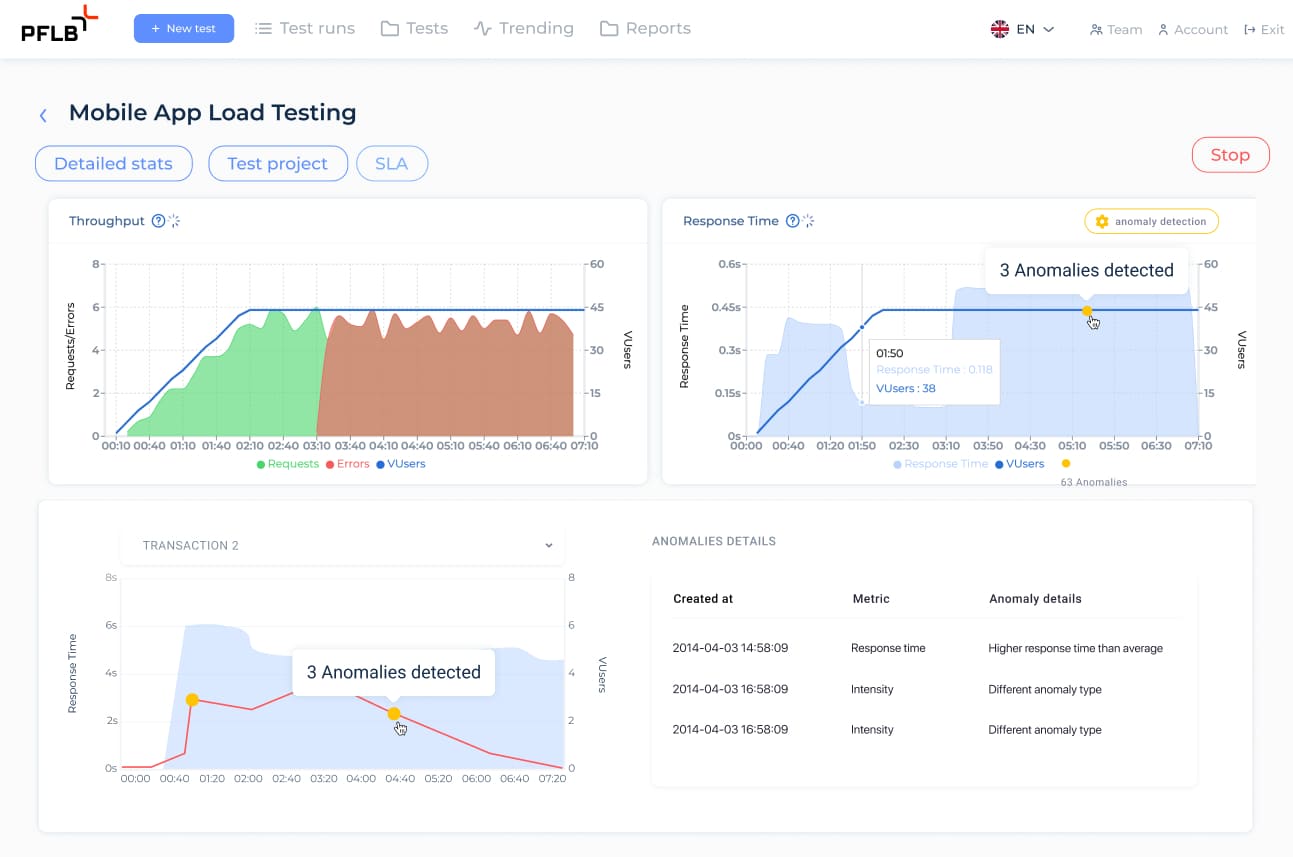When evaluating performance testing tools, many teams find themselves comparing LoadRunner vs NeoLoad; two powerful solutions trusted by enterprises worldwide. While there are many application performance testing tools available in the market, these two remain popular choices for enterprise environments. In this article, we’ll walk you through their core features, strengths, and limitations to help you make an informed choice.
But that’s not all! We’ll also introduce you to PFLB, a modern performance testing platform that combines the best of both tools while solving many of their drawbacks. Whether you’re testing APIs, enterprise applications, or cloud-native systems, this guide will help you choose the right tool for your development and business environment.
Key Takeaways
What Is LoadRunner?
LoadRunner (developed by Micro Focus, now part of OpenText) is one of the most established performance testing tools in the industry. Built to simulate virtual users and measure system behavior under heavy load, LoadRunner supports complex enterprise environments and remains a go-to solution for large-scale testing projects.
Its modular architecture separates test creation, execution, and analysis, allowing distributed and highly customizable test runs, from legacy applications to modern web services.
Key Features
Quick Summary Table of LoadRunner
| Aspect | Details |
| Protocol Coverage | HTTP/S, SAP, Citrix, Oracle, TCP/IP, and more |
| Test Design | GUI and advanced script-based (C, JavaScript) |
| Scalability | Enterprise-level (hundreds of thousands of users) |
| CI/CD Integration | Jenkins, Azure DevOps, Bamboo |
| Best For | Legacy apps, SAP, Citrix, large enterprises |
| Pricing | Complex, based on VU licenses and protocols |
| Main Challenges | Steep learning curve, resource-heavy, high licensing cost |
Advantages
Disadvantages
What Is NeoLoad?

NeoLoad (developed by Tricentis) is a modern performance testing platform designed to address the needs of agile and DevOps teams. Unlike traditional load testing tools built around legacy applications, NeoLoad focuses on speed, flexibility, and ease of use, enabling faster test creation and seamless integration into CI/CD pipelines.
It offers low-code and no-code options for test design, making it accessible to both technical and non-technical users, while also supporting complex performance testing for APIs, microservices, web, and mobile applications.
Key Features
Quick Summary Table of NeoLoad
| Aspect | Details |
| Protocol Coverage | HTTP/S, WebSocket, SAP GUI, Citrix |
| Test Design | Low-code, no-code, visual scripting |
| Scalability | Cloud-native, Docker/Kubernetes integration |
| CI/CD Integration | Native support for Jenkins, GitLab, Bamboo |
| Best For | Web apps, APIs, microservices, agile teams |
| Pricing | Subscription-based; can increase with scale |
| Main Challenges | Limited legacy protocol support, higher costs at enterprise scale |
Advantages
Disadvantages
NeoLoad vs LoadRunner: Main Differences
Now let’s break down the most relevant NeoLoad and LoadRunner differences to help you choose the right tool based on your project needs, environment, and business goals.
NeoLoad and LoadRunner Comparison Table
| Category | LoadRunner | NeoLoad |
| Protocol Support | 50+ protocols including SAP, Citrix, Oracle | Focus on HTTP/S, WebSocket, SAP GUI, Citrix |
| Deployment | On-premise (complex setup) | SaaS, cloud, on-premise, hybrid |
| Supported Platforms | Enterprise apps, SAP, legacy systems | Cloud-native apps, APIs, microservices |
| Ease of Use | Requires scripting expertise | Low-code/no-code visual test design |
| Reporting & Analytics | Detailed but technical; limited visuals | Real-time dashboards and SLA tracking |
| Performance & Scalability | Enterprise-grade but resource-heavy | Lightweight and cloud-native scalability |
| Pricing Model | License-based; complex tiers | Subscription-based; flexible and predictable |
| Best For | Legacy and enterprise testing | Agile teams, modern web and API testing |
Protocols
Deployment
Supported Platforms
Ease of Use
Reporting & Analytics
Performance & Scalability
Pricing & Licensing
Use Cases
Why PFLB Is a Better Choice Than LoadRunner and NeoLoad
While LoadRunner and NeoLoad are respected tools in the performance testing space, they come with challenges, from steep learning curves to complex pricing and limited flexibility for modern DevOps workflows.
PFLB was built to address these gaps, offering a smarter, faster, and more accessible solution for businesses of all sizes.
Full Protocol Coverage
PFLB supports a wide range of protocols, including HTTP/S, Web, APIs, SAP GUI, Oracle, Citrix, and more. Whether you’re testing lightweight APIs or complex enterprise applications, PFLB provides full protocol support without the need for additional plugins or third-party tools.
Quick Onboarding and Intuitive UI
Getting started with PFLB is fast and hassle-free. Its intuitive user interface, built-in test templates, and guided test creation flows make it easy for new users to design and execute complex load tests, without weeks of training.
Real-Time Analytics and Customizable Dashboards
PFLB delivers real-time performance monitoring with highly visual dashboards. Teams can customize metrics, track SLA compliance, and spot anomalies instantly, improving decision-making and reducing time to resolution.
Seamless CI/CD Integration
Unlike traditional tools that require heavy scripting to integrate with pipelines, PFLB natively connects with Jenkins, GitLab, Azure DevOps, and other CI/CD tools, enabling continuous performance testing with minimal configuration.
Effortless Cloud and Hybrid Scalability
PFLB scales dynamically, whether you need a few hundred virtual users or hundreds of thousands. Deploy tests on cloud infrastructure, on-premises, or hybrid environments without complex setup or manual scaling efforts.
Affordable, Transparent Pricing
With flexible plans tailored to your usage and needs, PFLB offers more affordable and predictable pricing compared to traditional license-based models. Every plan includes full-service support, giving your team direct access to performance testing experts whenever needed.
PFLB offers a complete performance testing alternative to LoadRunner and NeoLoad, with more flexibility, faster setup, and dedicated support at every step.
Whether you’re testing APIs, modern SaaS platforms, or large-scale enterprise systems, PFLB helps you optimize performance testing without the traditional complexity.
Final Thought
Both NeoLoad and LoadRunner are capable performance testing tools, but each comes with its limits, whether it’s around pricing structures, protocol coverage, or ease of use in modern environments.
If you’re looking for a modern, scalable, and expert-backed solution, PFLB combines the strengths of both while eliminating their complexity.
Try PFLB’s user-friendly platform today and simplify your load testing process!
Related insights in blog articles
Professional vs. In-House Website Load Testing: Which One Do You Really Need?

Thriving in the fierce digital space is what every business strives for. While high-traffic events like targeted marketing campaigns, paid ads, product launches, and seasonal spikes certainly help win over customers and skyrocket sales, they also abruptly expose hidden website vulnerabilities to users. To assess website readiness for traffic surges and prevent weaknesses, such as […]
How Website Performance Impacts E-Commerce Sales and Cart Abandonment

Every e-commerce store has mere milliseconds to make the right impression on shoppers. When prospects land on a product page, they assess every single metric, and e-commerce website performance and speed are the most critical ones. In most scenarios, impatient users will bounce instantly — at the slightest hint of latency caused by high loads […]
10 Signs Your Website Can’t Handle Traffic Spikes: Everything you need to know

Your campaign goes live, clicks start pouring in, and traffic shoots up fast. It’s the moment you’ve been waiting for, until everything slows down. Pages take ages to load, checkout freezes, and visitors disappear before they can buy. It’s a frustrating twist: the success of your marketing draws in more people than your website can […]
Why Averages Lie: Mathematical Methods for Load Testing

Relying on “average” metrics alone makes load testing surprisingly inaccurate. In this article, we’ll show how to avoid the usual traps and walk through practical techniques for mathematically modelling a workload profile, from analyzing variance and correlations to spotting Simpson’s paradox and validating the final model. When a company moves to a new system, the […]
Be the first one to know
We’ll send you a monthly e-mail with all the useful insights that we will have found and analyzed
People love to read
Explore the most popular articles we’ve written so far
- Top 10 Load Testing Tools for 2025: The Deep Dive Sep 9, 2025
- Cloud-based Testing: Key Benefits, Features & Types Dec 5, 2024
- Benefits of Performance Testing for Businesses Sep 4, 2024
- Android vs iOS App Performance Testing: What’s the Difference? Dec 9, 2022
- How to Save Money on Performance Testing? Dec 5, 2022


